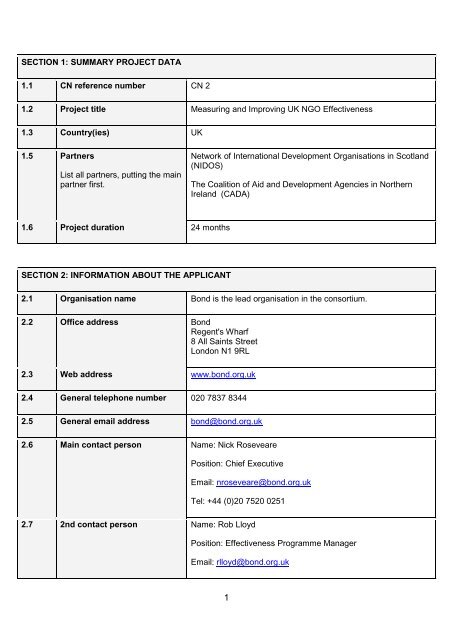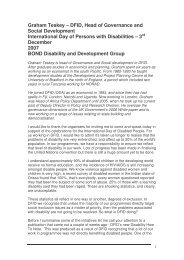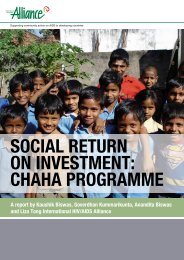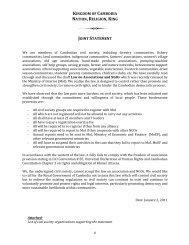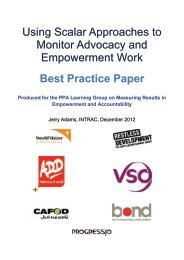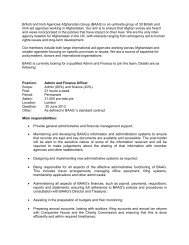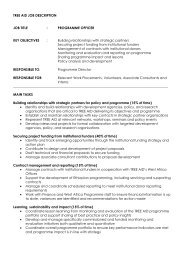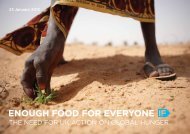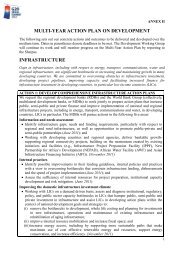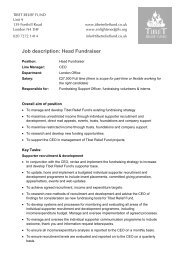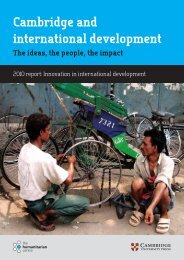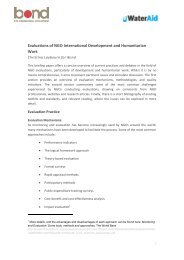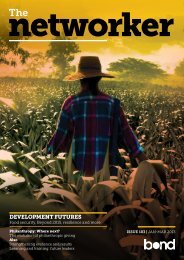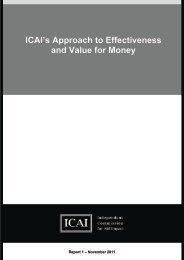Proposal - Improving UK NGO Effectiveness - Bond
Proposal - Improving UK NGO Effectiveness - Bond
Proposal - Improving UK NGO Effectiveness - Bond
Create successful ePaper yourself
Turn your PDF publications into a flip-book with our unique Google optimized e-Paper software.
SECTION 1: SUMMARY PROJECT DATA1.1 CN reference number CN 21.2 Project title Measuring and <strong>Improving</strong> <strong>UK</strong> <strong>NGO</strong> <strong>Effectiveness</strong>1.3 Country(ies) <strong>UK</strong>1.5 PartnersList all partners, putting the mainpartner first.Network of International Development Organisations in Scotland(NIDOS)The Coalition of Aid and Development Agencies in NorthernIreland (CADA)1.6 Project duration 24 monthsSECTION 2: INFORMATION ABOUT THE APPLICANT2.1 Organisation name <strong>Bond</strong> is the lead organisation in the consortium.2.2 Office address <strong>Bond</strong>Regent's Wharf8 All Saints StreetLondon N1 9RL2.3 Web address www.bond.org.uk2.4 General telephone number 020 7837 83442.5 General email address bond@bond.org.uk2.6 Main contact person Name: Nick RosevearePosition: Chief ExecutiveEmail: nroseveare@bond.org.ukTel: +44 (0)20 7520 02512.7 2nd contact person Name: Rob LloydPosition: <strong>Effectiveness</strong> Programme ManagerEmail: rlloyd@bond.org.uk1
Tel:+44 (0)20 7520 1047SECTION 3: CAPACITY OF APPLICANT3.1 EXPERIENCEPlease outline your experience in relation to the issues targeted in the proposal<strong>Bond</strong>, as the lead partner in a Consortium with NIDOS and CADA, has a long-standing commitmentto improving the effectiveness of its members. <strong>UK</strong> development <strong>NGO</strong>s and the Consortium partnersconsider <strong>Bond</strong> well placed to lead this work. The proposed programme represents a continuation of<strong>Bond</strong>’s work on developing the <strong>UK</strong> international development sector’s effectiveness. Over the pastyear the <strong>Bond</strong> <strong>Effectiveness</strong> Programme has built up the engagement, momentum and contributionof over 50 <strong>NGO</strong>s for developing a sector-wide approach to managing and assessing effectiveness.NIDOS is similarly well placed, having worked for the past four years on building effectivenessamongst organisations in Scotland, with over 40 member <strong>NGO</strong>s participating in the development oftheir recently launched pilot <strong>Effectiveness</strong> Self-Assessment Tool tailored for small <strong>NGO</strong>s, with inputfrom <strong>Bond</strong>.While CADA does not currently conduct activities on supporting its members to improveeffectiveness, its 23 members are keen to benefit from <strong>Bond</strong> and NIDOS collective experience inthis area and being involved in the development and application of common Frameworks, tools andresources for improving <strong>UK</strong> <strong>NGO</strong> effectiveness.3.2 FUNDING HISTORYPlease provide a brief summary of your experience with projects of this size and scope<strong>Bond</strong> has recently successfully delivered on a major long-term programme grant from the BigLottery Fund of £750,000 over three years. The Bill and Melinda Gates Foundation recently funded<strong>Bond</strong> through a grant of £166,000 for a one year Millennium Development Goals project and iscurrently considering a proposal for longer term funding. <strong>Bond</strong> received project specific funding fromDFID including for both EU work and for <strong>Effectiveness</strong> work as an addendum to our most recentStrategic Funding Agreement which, as a result, totalled £1,157,608 over two years. DFID has beenfunding <strong>Bond</strong> to ensure that mutual strategic aims for the sector are met, since 1993. All of thisfunding has been managed in accordance with the Charity Commission Statement ofRecommended Practice, and has been fully evaluated and the reports are available in the publicdomain on the <strong>Bond</strong> website.NIDOS has managed grants from the Scottish Government since 2005 including £132,000 in 2010.£72,000 of this was specifically to develop and pilot the <strong>Effectiveness</strong> Self-Assessment Tool and torun outreach to secure engagement.CADA is hosted by Concern Northern Ireland and therefore does not manage grants directly oremploy staff. Events and activities are currently funded by contributions from member organisationswhich total c.£4,000 a year.2
3.3 FRAUDAre you aware of any fraudulent activity within your organisation within the last 5 years?How will you minimise the risk of fraudulent activity occurring in future?No. All Consortium members have systems in place to minimise the risk of fraudulent activity;notably, signatories are required to ensure that all expenditure is in line with agreed budgets and werequire evidence of expenditure prior to paying expenses.SECTION 4: PROJECT BUDGETNote that this should be a summary extracted from the full budget submitted together with this applicationwhich must be presented in DFID financial years (1 st April - 31 st March).4.1 Total Project Budget £414,0074.2 Total funding requested fromDFID4.3 Funding requested from DFIDin year 1£239,498£119,5304.4 If you have approached other donors for funding for this project, please give name ofdonors, reference number, and status of application. Please also list any contributions ofyour own.Given the importance of <strong>NGO</strong> ownership to the success of this work, <strong>Bond</strong> members have madesubstantial contributions from their own unrestricted financial resources to the Programme, over andabove the annual <strong>Bond</strong> core membership fees. In the first year of the <strong>Effectiveness</strong> Programme,members contributed £30,000, while in 2011/12 voluntary contributions stand at £62,000 and rising.This increase in financial contributions is a reflection of <strong>NGO</strong> Chief Executives’ growing confidencein and ownership of the programme. The Consortium has also secured a small amount of financialsupport from Comic Relief (£20,000) to resource expert technical inputs into one specific componentof the programme: the Framework of common indicators and assessment methods).NIDOS has secured a grant of £126,103 from the Scottish Government for the coming financial yearwhich will cover the staffing costs associated with this work. Therefore NIDOS has requested that gfrom DFID would cover activities and enable a higher involvement of members in Scotland. NIDOSwill also be generating income from members for this work over the year (projected input of £5,000from NIDOS members into this project).SECTION 5: BASIC INFORMATION ABOUT THE PROJECT5.1 ACRONYMSPlease list all acronyms used in your application and explain them in full. Please list acronyms inalphabetical order.3
BEP <strong>Bond</strong> <strong>Effectiveness</strong> ProgrammeBOAG British Overseas Aid Group [ActionAid, CAFOD, Christian Aid, Oxfam, Save the Children]CADA Coalition of Aid and Development Agencies within Northern IrelandEFQM European Foundation for Quality ManagementHAP Humanitarian Accountability PartnershipM&E Monitoring and Evaluation<strong>NGO</strong> Non-Governmental OrganisationNIDOS Network of International Development Organisations in ScotlandPQASSO Practical Quality Assurance System for Small Organisations5.2 BRIEF DESCRIPTION: 1 sentenceThe programme involves <strong>Bond</strong>, NIDOS & CADA (the Consortium) leading a process with itsmembers to ensure <strong>UK</strong> <strong>NGO</strong>s are able to prove and improve their contribution to poverty reduction.5.3 PROJECT SUMMARY: maximum 10 lines - Outline the overall aim of the project, the expectedoutcomes, what change the project is intending to achieve and who will benefit.The overall goal is to create real incentives for <strong>UK</strong> <strong>NGO</strong>s to deliver greater long term impact tothose living in poverty. The specific contribution of the programme is to ensure that <strong>UK</strong> <strong>NGO</strong>s areglobal leaders in demonstrating their contribution to poverty reduction, having the necessarycapacity and incentives to continually improve performance through the application of practical,innovative approaches to measuring, managing and reporting effectiveness. The expectedoutcomes are: agreement to, and implementation of two sector wide common frameworks formeasuring effectiveness; strengthened skills and knowledge to manage effectiveness; and anenabling environment that encourages and supports <strong>UK</strong> <strong>NGO</strong>s to improve effectiveness. Theprimary beneficiaries are <strong>UK</strong> <strong>NGO</strong>s, of which a high proportion are small to medium sized andhave identified that they require support in this area.SECTION 6: PROJECT RATIONALE6.1 PROBLEM TO BE ADDRESSEDWhat problem will this project address? How was the problem identified? How will your projectaddress the problem?<strong>UK</strong> <strong>NGO</strong>s struggle to provide rigorous and consistent evidence of the contribution they make topoverty reduction. This undermines performance-based decision making, weakens learning andeffectiveness, and ultimately feeds public scepticism towards international development, asdemonstrated in a recent <strong>Bond</strong> report, Finding Frames: New ways to engage the <strong>UK</strong> public in globalpoverty.4
Research and analysis of the <strong>Bond</strong> membership on quality and effectiveness between 2006 and2010, and the NIDOS membership since 2008, has consistently identified weaknesses in M&E,impact evaluation and transparency as barriers to improved performance and areas where there is aneed to develop sector practice. A recent <strong>Bond</strong> survey for example, indicated that 74% ofrespondents needed support in assessing and demonstrating their impact.The emphasis currently being given to the results and value for money agendas within internationaldevelopment by funders, public and the media provides a unique opportunity for the Consortium tolead <strong>UK</strong> <strong>NGO</strong>s in tackling these long recognised weaknesses in the sector. Attention among <strong>UK</strong><strong>NGO</strong>s to issues of effectiveness has never been so great. The Consortium is excellently placed tocapitalise on this energy and channel it into developing a sector wide, commonly ownedunderstanding and approach to measuring and managing effectiveness that reflects the distinctivecontributions <strong>NGO</strong>s make to international development. To this end the Consortium will lead andfacilitate their members to undertake three interlinked streams of work:1. Develop agreement, and support implementation of, two commonly owned sector wideframeworks for improving effectiveness:a) A ground breaking framework of common indicators and assessment methodsdesigned to improve the rigour and consistency of how <strong>NGO</strong>s measure and demonstrateeffectiveness depending on their strategies for change (direct service delivery, advocacy andcampaigning, enterprise development, and/or capacity building) and thematic area of work(markets and livelihoods, governance and accountability, health and HIV/AIDS, rights andempowerment, education, infrastructure services, care and protection, and environmentalsustainability). The framework will define what an organisation should assess, how it shouldbe assessed, and what should be reported to whom and how.b) An innovative online effectiveness self-assessment and resource portal that enablesbenchmarking between <strong>UK</strong> <strong>NGO</strong>s, and helps them to improve their internal capacities foreffectiveness by identifying strengths and weaknesses and providing tailored signposting torelevant resources to address specific capacity gaps.2. Build the necessary skills and knowledge among <strong>UK</strong> <strong>NGO</strong>s to support the use andimplementation of the self-assessment and the Framework of common indicators for improvingeffectiveness. This will be achieved through the delivery of high quality training, facilitating peerlearning and support, developing guidance notes and how to guides on issues such as value formoney, supporting the piloting of new approaches to measurement and developing and sharinggood practice case studies.3. Create an enabling environment across the <strong>UK</strong> <strong>NGO</strong> sector that encourages and supportsorganisations to improve their effectiveness. This will be achieved through focusedengagement with senior managers of <strong>NGO</strong>s and funders of <strong>UK</strong> <strong>NGO</strong>s to build support for theuse of the effectiveness frameworks; advocating for a more consistent and transparentdisclosure of data as a means of driving improvements in performance; and encouragingbenchmarking as a means of encouraging peer learning and stimulating pressure for improvingeffectiveness.6.2 TARGET GROUP (DIRECT BENEFICIARIES)Who are the direct beneficiaries? How many people are they and how have you determined thisnumber? Please provide an absolute number (e.g. 300 children rather than children in 3 schools)plus a breakdown by age and gender. How were the target group identified? Why were theyselected? What consultation has been undertaken with the target group in designing your project?5
The primary beneficiaries are the 484 member <strong>NGO</strong>s of the Consortium, of which a highproportion are small to medium sized organisations and have identified that they requiresupport in this area. They make up over 80%, 70% and 25% of <strong>Bond</strong>, NIDOS and CADA’smembership respectively, and have a combined development budget of in excess of £330millon. Weestimate that this group employ at least 3,000 people in the <strong>UK</strong>, often supporting staff andvolunteers internationally and managing multiple areas of work, meaning a frequent lack ofdedicated capacity and resources to improve effectiveness and provide evidence of their impact onthe lives of those living in poverty. A recent <strong>Bond</strong> survey identified ‘time and resources’ and ‘lack oftechnical expertise’ as the most significant challenges to improving effectiveness. By developingcollective tools and common frameworks for improving effectiveness and supporting theirimplementation, the Consortium is providing an important service to its members and significanteconomies of scale.Key to the success of the programme is the ongoing involvement of <strong>UK</strong> <strong>NGO</strong>s in the development ofthe common tools and frameworks. This has been a key principle of <strong>Bond</strong>’s and NIDOS’effectiveness programmes since their inception in 2009 and 2008 respectively. Together these twoprogrammes currently have 94 <strong>NGO</strong>s actively engaged in shaping the frameworks and tools beingdeveloped.6.3 TARGET GROUP (INDIRECT BENEFICIARIES)Who are the indirect (wider) beneficiaries? How many people are they and how have youdetermined this number? As above – please specify absolute numbers if possible.The links between <strong>Bond</strong>, NIDOS and CADA and poor and marginalized women and men aremediated through their members, and their members’ partners. The programme provides anessential link in the results chain by creating the enabling conditions which are necessaryfor <strong>NGO</strong>s to have a sustained and positive impact on poverty. The programme will strengthenthe capacity, rigour and consistency with which <strong>NGO</strong>s measure and manage their effectiveness; inso doing, <strong>NGO</strong>s will have strengthened capacities to learn from and identify what has been effectivein supporting poor and marginalised men and women to make positive and sustainable changes totheir lives. Such evidence will enable organisations to identify successful models for povertyreduction, and inform future programme design and implementation.Donors to <strong>UK</strong> development <strong>NGO</strong>s (this includes Baring Foundation, Big Lottery Fund, ComicRelief, DFID, Diana, Princes of Wales Memorial Fund, Nuffield Foundation, Bill and Melinda GatesFoundation, Sainsbury Family Charitable Trusts, Wellcome Trust, EU agencies) will benefit from theprogramme through greater consistency and improved comparability between <strong>NGO</strong>s on how theydemonstrate effectiveness. Through the implementation of common performance indicators, funderswill be better placed to compare effectiveness across their portfolio of grantees and identify highperforming organisations. In addition, the online effectiveness self-assessment will provide funderswith a common tool to understand strengthens and weaknesses in grantees’ capacities and informcapacity support for improving effectiveness. Likewise, the online resource portal will be a commonresource that funders can direct grantees to for sign posting to appropriate tools, approaches andinitiatives for improving effectiveness.Other <strong>NGO</strong> national networks and their members will have access to the online portal and willtherefore benefit from the resources that are collected. We are already also discussing with <strong>NGO</strong>platforms such as CONCORD (EU), Partos (Netherlands) Coordination Sud (France) andInterAction (US) on the use of the common indicators framework for their contexts, which will alsobe freely available online.6
6.4 LESSONS LEARNEDWhat lessons have you drawn on (from your own and others’ past experience) in designing thisproject?The approach taken in this programme draws from the Consortium’s extensive experience ofdeveloping the capacity among its membership through tailored training, peer learning and thedevelopment of resources. <strong>Bond</strong> has delivered training and other learning support to <strong>UK</strong> <strong>NGO</strong>ssince 1993, and has extensive technical expertise and a sound reputation as a provider in this area.From 2008-10, <strong>Bond</strong>’s training programmes provided direct knowledge and skills development toalmost 1,000 learners, and NIDOS’ to over 200. The quality of <strong>Bond</strong> training courses on <strong>NGO</strong><strong>Effectiveness</strong> have been rated nine out of ten over 2009-11.Members of the Consortium have also consulted widely with their own member organisations, other<strong>NGO</strong> platforms and existing effectiveness initiatives to ensure the programme builds on existingexperience of how best to drive improvements in sector wide performance and build consensusaround sector wide frameworks. <strong>Bond</strong> commissioned independent research in 2010 into theexperiences of 11 effectiveness initiatives from both the <strong>NGO</strong> sector (HAP, People and Aid,PQASSO) and the corporate sector (ISO 9000, EFQM) to inform the development of its ownframeworks. The findings highlighted a number key points:1. In light of the plethora of tools, frameworks and initiatives in the <strong>NGO</strong> sector, there is a need foran overarching effectiveness framework that draws existing resources together, shows thelinkages and overlaps between them and steers organisations to the ones most relevant to theirindividual needs.2. The focus of existing effectiveness initiatives within the <strong>NGO</strong> sector is primarily on the systemsand procedures that support effective work, as such they focus on process indicators, noneidentify outcome and impact indicators, despite this being the area where most <strong>NGO</strong>s struggle.3. In order to encourage the uptake of any framework, <strong>Bond</strong> should look at a range of mechanismsfor incentivising and supporting its use including creating spaces for peer learning and support,developing a range of support products such as tools, guides, case studies and training, andengaging donors in its development and promotion.Finding 1 has influenced the design and content of the online effectiveness self-assessment andresource portal, while finding 2 has formed the basis for the Im-Prove it! Framework. Finding 3 hasinfluenced the approach being taken to build skills and knowledge within the sector and in creatingan enabling environment for effectiveness.SECTION 7:PROJECT DESIGN7.1 APPROACH AND EFFECTIVENESSPlease provide details on the project approach (or methodology) to address the problem you havedefined. You should also justify why you consider this approach to be the most effective way inwhich to reach the project’s purpose. Please justify the timeframe and scope of your project.The programme involves three interlinked streams of work: developing common effectivenessframeworks, building skills and knowledge for improved effectiveness and creating an enablingenvironment for improved effectiveness across the sector. Each is an essential component ofstrengthening <strong>UK</strong> development <strong>NGO</strong>s’ effectiveness.7
1. Developing agreement among <strong>UK</strong> <strong>NGO</strong>s on common effectiveness Frameworks willprovide a common language across the sector in relation to performance, and a commonresource for small and medium sized agencies that may lack the capacity to develop bespokeframeworks themselves. The effectiveness self-assessment and online resource portal willprovide members with a flexible yet structured way of identifying strengths and weaknesses intheir ability to be effective, inform capacity development plans and provide the basis formonitoring capacity building efforts. Being online, it will also allow organisations to compare andbenchmark their scores with peers. This data will form the basis for facilitated learning between<strong>NGO</strong>s, and be used to generate positive pressure between organisations to improveperformance (see point 2 below). The Framework of Common indicators and assessmentmethods is a tool designed to improve the rigour and consistency of how <strong>NGO</strong>s measure anddemonstrate effectiveness. This is an area where <strong>UK</strong> <strong>NGO</strong>s have consistently struggled toimprove practice. Depending on an organisation’s strategies for change (see 6.1, 1.a above) andthematic area of work (see 6.1, 1a above) the framework will define what an organisation shouldassess, how it should be assessed, and what should be reported, to whom and how.2. In supporting <strong>UK</strong> <strong>NGO</strong>s to develop the skills and knowledge for improved effectiveness,the approach taken will combine a mix of resource development, one-on-one or peer support,and learning and training. To support implementation of the effectiveness self-assessment, aprocess guide will be developed that outlines the steps organisations should take in conductingthe self-assessment, who to involve, what evidence to use, how to develop an improvement planetc. This will be accompanied by an online training module on how to use the web platform,resource portal and the benchmarking function. To encourage early adoption of the tool,consultancy support will be offered to a limited number of organisations to facilitate the selfassessmentprocess and provide support in developing an improvement plan. Longer term, amentoring system will be established where new users of the self-assessment will be pairedwith those already familiar with the tool. The online resource portal will serve as an importantpoint of ongoing information and support for improving effectiveness. Based on the results of theself-assessment, organisations will be signposted to the tools, approaches and training mostappropriate for addressing their specific capacity gaps. To encourage the use of thebenchmarking function and to encourage organisations to take advantage of what this offers interms of learning and improvement, benchmarking groups will be established. These will becomposed of groups of <strong>NGO</strong>s that are committed to improving effectiveness and want to usebenchmarking data as the basis for structured learning and sharing with peers. Aggregating theresults of individual organisational online self-assessments will also inform the Consortium ofcommon capacity gaps in the sector and shape ongoing sector wide training on <strong>NGO</strong>effectiveness.To build the skills and knowledge of <strong>UK</strong> <strong>NGO</strong>s to improve the consistency and rigour of howthey measure and report effectiveness, the programme will develop guidance notes on how touse the framework of common indicators and an online training module to accompany this.Peer groups structured around the eight thematic areas of the common indicator Frameworkwill provide support on implementing and sharing experience on measuring effectiveness indifferent sectors. Innovative data collection tools and assessment methods identified in thecourse of developing the Framework will be showcased through how to guides. A small amountof funding will also be provided to organisations to support and incentivise the piloting of newapproaches to measurement. The 30 tracker studies that are to be conducted as part of theprogramme’s monitoring and evaluation system will also provide a rich source of learning andexperience for the sector, particularly in understanding the conditions and factors which linkimproved systems for effectiveness to improved outcomes and impact. These studies will bedisseminated widely within the sector.In building skills and knowledge for improved effectiveness, a particular emphasis will be givento value for money. This is an area where many <strong>UK</strong> <strong>NGO</strong>s are currently struggling. The8
programme has already convened a series of workshops on this issue, and will be establishing aworking group to lead on integrating value for money into the two Frameworks being developed,and to serve as a space for sharing learning and mutual support on implementing different valuefor money methods. Within the first six months of the programme, <strong>UK</strong> <strong>NGO</strong>s will produce abackground paper to support the sector in improving value for money.3. Creating an enabling environment for improved effectivenessWhile providing frameworks and building skills and knowledge is important, in order to be asuccess the programme needs to create an environment in which <strong>UK</strong> <strong>NGO</strong>s are stronglyencouraged to improve their effectiveness. To do this, the programme wil focus on engagingdonors, influencing <strong>NGO</strong> leaders and encouraging transparency. As funders of <strong>NGO</strong>s,donors play a key role in incentivising improved effectiveness. The programme will activelyengage them in the development of the Frameworks and encourage them to promote their useamong grantees. Senior managers and trustees of <strong>NGO</strong>s have a similarly important role indriving organisational change and improving perfomance. The programme will specificallyengage senior managers of Consortium members through the BOAG group, InternationalProgramme Directors, Directors of Small <strong>NGO</strong>s, and the Leaders’ Series. Together these groupsconvene leaders of close to 200 organisations every four to six months to debate and sharelearning on issues of strategic significance; they are ideal spaces to engage meaningfully withthis key constituency, and to enable a shared and robust understanding of effectiveness and theFrameworks to be developed. Lastly, the programme will seek to motivate <strong>UK</strong> <strong>NGO</strong>s to invest inand improve effectiveness by encouraging greater transparency of performance across thesector. By improving the quality and accessibility of information available to stakeholders about<strong>NGO</strong> effectiveness, the programme seeks to create an environment in which it is easier toscrutinise organisations’ activities and to hold them to account for their performance. TheConsortium’s proposal on ‘Implementing Standards of <strong>NGO</strong> Transparency’ will play a key role inrealising this objective, as will the role of sector benchmarking through the online effectivenessself-assessment.Timeframe: - The proposed programme of work will run for 24 months. The first year will be used tofinalise the development, piloting and revision of the effectiveness tools and frameworks. Thesecond year will be used to work with <strong>UK</strong> <strong>NGO</strong>s to support implementation and develop andintegrate activites into ongoing activities of Consortium members.7.2 VALUE FOR MONEYIt is important that projects provide good value for money. Please explain in what way your proposalwill offer the maximum benefit for the resources requested. What alternative approaches could havebeen applied and why have they been ruled out?The requested resources from DFID represent only 58% of the total project costs, which are beingcovered by contributions already made by members and the Scottish Parliament’s funding ofNIDOS. Member contributions to date exceed £62,000 and include those from: Action Aid <strong>UK</strong>,Care, CAFOD, Christian Aid, EveryChild, Islamic Relief, Mercy Corps, Oxfam GB, Plan <strong>UK</strong>,Practical Action, Save the Children, Sightsavers, Wateraid and World Vision. Overall, the cost baseis comparatively low in relation to the potential spread of benefits and national and internationalreach of the project. Specifically the proposed programme of work offers value for money in twoways:1. The multiplier effect of working through membership organisationsBy supporting the Consortium to coordinate and lead the sector in defining a common approach tomeasuring effectiveness, DFID is funding one initiative to mobilise 484 organisations around a9
collective agenda. An independent external evaluation of the <strong>Bond</strong>/DFID PPA indicated the value ofthis approach: “[…] <strong>Bond</strong>’s capacity to leverage the efforts of its members and <strong>UK</strong> development<strong>NGO</strong>s more broadly provides a “multiplier effect’. In this respect, <strong>Bond</strong> represents a return oninvestment in terms of its capacity to leverage the activities of others and influence the quality andeffectiveness of these activities.”In addition, by developing collective tools and common frameworks for improving effectiveness andsupporting their implementation, the Consortium is providing significant economies of scale. Manysmaller and medium sized Consortium members lack the capacity to develop bespoke effectivenessframeworks; the programme is developing common resources that they can draw on and adapt asnecessary.2. Cost efficiencies in key areas of programme spendSalaries represent the largest portion of programme spend. It would not be possible to deliver theprogramme without the current Programme Manager and Programme Administrator at <strong>Bond</strong>, or theNIDOS Coordinator and Good Practice Officer which are being funded by the Scottish Government.As a recent external evaluation states “[…] <strong>Bond</strong> salaries are fixed within a salary scale identified byCroner Reward using their extensive database; the external benchmark is the median of thecharitable sector with a similar profile to <strong>Bond</strong> in terms of income, number of employees, andlocation.Consultancies represent the next highest spend for the programme. While considerable work isundertaken through the in-kind contributions of members’ knowledge and expertise, there arecertain points in the process where additional expert capacity is required. We are fortunate to bereceiving £20,000 from Comic Relief towards the costs of consultancies and, where we would needto commission work, the process used by <strong>Bond</strong> would be an open tendering process to ensurecompetitive pricing in accordance with our policies.7.3 BENEFICIARY INVOLVEMENTPlease specify how the project beneficiaries will be involved in the implementation, managementand monitoring of the project.Ongoing consultation with and involvement of <strong>UK</strong> <strong>NGO</strong>s in the programme are key to its success.<strong>UK</strong> <strong>NGO</strong>s are involved in management through a programme steering group that providesstrategic oversight of the programme. Current members include: VSO, Sightsavers, Toybox, StarsFoundation, Islamic Relief and One World Trust (including several Chief Executives). Members areinvolved in implementation through technical working groups that oversee the development ofeach of the two frameworks. The group overseeing the Framework of common indicators iscomposed of: Cafod, Christian Aid, EveryChild, Leonard Cheshire Disability, Womankind andNIDOS (also including both technical experts and Chief Executives). Additional groups are alsobeing established around the eight thematic areas of the Framework (see 6.1, 1a above) to lead inthe identification of common indiators and assessment methods. The group overseeing theeffectiveness self-assessment includes: SelfHelp Africa, Tree Aid, International Child Care Trust,ActionAid <strong>UK</strong>, Concern Universal and Toy Box (including several Chief Executives). Additionalgroups will be established for piloting each of the frameworks. Members are involved inmonitoring through participation in post-event evaluation and an annual effectiveness survey of <strong>UK</strong><strong>NGO</strong>s; a sample will also be involved in tracking changes in their capacities for effectivenessthrough a self-assessment tool and in investigating how investments in effectiveness systems areinfluencing outcomes through a number of tracker studies.7.4 OTHER AGENCIES (WIDER CONTEXT)10
What other agencies, including Government are involved in the areas where this initiative will takeplace and how will you work with them? How will the project address gaps, complement otherinitiatives and avoid duplication?The programme is closely linked with other initiatives addressing issues of <strong>NGO</strong>effectiveness. <strong>Bond</strong> commissioned independent research in 2010 to identify where it can addgreatest value to these (see 6.4 above for details on recommendations).Both <strong>Bond</strong> and NIDOS actively seek the involvment of other actors at different stages in thedevelopment of the programme. For example, the NIDOS <strong>Effectiveness</strong> Tool and the <strong>Effectiveness</strong>self-assessment are both directly informed by and consistent with the Istanbul Principles on CSO<strong>Effectiveness</strong> and show clear links to other initiatives, such as the Disasters Emergency CommitteeAccountability Framework, HAP, People in Aid and PQASSO. In addition, the programme alreadyengages, and will continue to engage, a range of other actors on specific effectiveness themes. Wehave run training on Value for Money with the New Economics Foundation, on Impact evaluationwith 3ie and subsidised members to join Keystone’s partner accountability survey. We are also incontact with Charities Evaluation Services and New Philanthropy Capital on their experinces ofdeveloping frameworks of common indicators. The programme will also continue to share learningand experience with other platforms to avoid duplication and capitalise on synergies.The programme will continue to engage with DFID on relevant aspects of the effectivenessagenda, including value for money, transparency, demonstrating results in governance work,and evaluation standards for the <strong>NGO</strong> sector.The Consortium is actively engaging funders of <strong>UK</strong> <strong>NGO</strong>s in the development of the frameworks.Comic Relief, Sainsbury’s Charitable Trust, Diana, Princess of Wales Memorial Fund, BaringFoundation and the Nuffield Foundation are all currently involved in the effectiveness programme indifferent ways. The Scottish Government is very supportive of NIDOS’ work on effectiveness andwill work to ensure that organisations in Scotland engage with this project.7.5 SUSTAINABILITYWhat are the prospects for the benefits of the project being sustained after the funding stops?This section should also explain why the timeframe you have specified for the project is sufficient toreach the project’s objectives and how it will support the achievement of sustainability.It is envisaged that the staffing levels and associated project costs in the current period will not berequired at the same level at the end of the funding period. Over the life of the programme weexpect to build the frameworks and activities to support their use into the existing work of theConsortium members. <strong>Bond</strong> intends to integrate the Im-Prove it! Framework and theeffectiveness self-assessment into the <strong>Bond</strong> Statement of Principles, thus making their use amembership requirement. NIDOS will train freelance mentors, who will be available at the end ofthe project period to assist Scottish <strong>NGO</strong>s to use the tools. The networks and relationships builtbetween organisations through the peer groups would continue to provide support onimplementation of the tools beyond the life of the programmes. Similarly, an introduction to thetools and the importance of building the effectiveness of the sector will be built into theinduction of all new members of the three Consortium partners and the informal mentoring ofnew members by those who have used the tools will encourage uptake. In addition, the Learningand Training teams at <strong>Bond</strong> and NIDOS will use the results of the self-assessment to identifyevolving sector needs and develop appropriate training to provide capacity support in areas ofweakness. <strong>Bond</strong> also works closely with the Quality Group, a member run initiative, which has beenin existence since 2006 and is working with the group’s chair on how implementation of the common11
indicator Framework and the wider agenda of strengthening how <strong>NGO</strong>s measure and demonstrateeffectiveness can be taken forward.The first year of funding requires a substantial level of inputs to build on the momentum alreadyestablished and complete both the frameworks. The second year of funding will be focused onbuilding the skills and knowledge and creating the necessary incentives and support structures thatwill ensure the implementation of the frameworks beyond the life of the programme.SECTION 8: PROJECT MANAGEMENT8.1 PROJECT MANAGEMENTPlease outline what are the project implementation and management arrangements for this project.Note: This should include:A clear description of the roles and responsibilities of each of the partners. You may wish toinclude as an appendix an organogram of the project staff showing which staff are part of whichpartner organisation and how the partners relate to each other.A clear description of the added value of the each organisation within the project.An explanation of the human resources (number (in full- time equivalents), type, skills,background, gender, nationality) required. You should specify whether these are newresources or are already in place.An outline and justification of the material inputs (equipment) required for the project.Added value of the ConsortiumThere are two major benefits of the Consortium: reach and coherence.1. Reach: Small and medium-sized organisations are widely dispersed across the <strong>UK</strong>, and manyhave limited resources. Local networks can be better suited to meet some of their needs. TheConsortium achieves a greater reach for information, training and learning than any one networkalone.2. Coherence: Scarce resources cannot be wasted duplicating activity. Benefits of Consortiumworking can already be seen in the stronger collaboration and alignment between <strong>Bond</strong> andNIDOS on the <strong>Effectiveness</strong> agenda and the extension of this work to Northern Ireland.Roles, responsibilities and added value of each Consortium member<strong>Bond</strong> is the largest of the three partners with a membership of 370 organisations. It has the majorityof dedicated capacity for moving forward the programme, with two existing staff positions(<strong>Effectiveness</strong> Programme Manager and Programme Administrator) and will manage the funds onbehalf of the Consortium. <strong>Bond</strong> staff working on the day to day activities to move the development ofthe effectiveness self-assessment and the Framework of common indicators forward (e.g.conducting background research, synthesising member feedback, developing backgrounddocuments and managing any consultants) will work in close collaboration with NIDOS and CADAon this. <strong>Bond</strong> is responsible for facilitating the engagement of their members in the development ofthe Frameworks and providing support to implementation. Because of the limited capacity of CADA,<strong>Bond</strong> will support CADA in engaging its members in the development of the Frameworks andhelping it establish structures that support implementation. Ten percent of <strong>Bond</strong> programme staff12
time has been dedicated to offering additional support to CADA.NIDOS has a membership of 91 organisations. It plays an important role in the programme, bothfeeding in its experience of piloting its self-assessment tool, particularly in relation to uptake by smalland medium-sized organisations and the challenges they face, and active involvement in thedevelopment of the Framework of common indicators and assessment methods. This will be doneboth through the BEP quarterly meetings and through direct input. NIDOS will enable memberengagement in the consultation and development of the Framework, particularly in the three sectorswhere a significant numbers of its members are engaged (Education, Health and HIV/AIDS,Livelihoods and Markets). NIDOS will also facilitate, with support from <strong>Bond</strong> where needed,information sessions and peer sharing sessions in Scotland in relation to testing and promoting thecommon indicators framework, disseminate information on effectiveness resources, and run trainingon M&E. The NIDOS Coordinator will be a member of the working group leading the development ofthe Framework of Common Indicators and assessment methods and a member of the ProgrammeSteering GroupCADA has a membership of 23 organisations. CADA is hosted by Concern Northern Ireland anddoes not have staff dedicated to the network itself so their capacity to engage with the programme ismore limited than <strong>Bond</strong> and NIDOS. CADA events and activities, for example, are currently fundedby contributions from member organisations which are approx. £4,000 a year. Yet, CADA membersare eager to input and benefit from the programme. To this end, CADA’s role is specifically tocommunicate and promote the work that <strong>Bond</strong> and NIDOS are doing, enable CADA members toengage in the development of the Frameworks and, with the support of <strong>Bond</strong>, establish structuresfor supporting implementation which are appropriate to the Northern Irish <strong>NGO</strong> context. CADAmembers will be involved in piloting the effectiveness self-assessment tool and participate in taskgroups taking forward the common indicators Framework. The CADA Chair will be a member of theProgramme Steering Group and a member agency will be a member of the working group leadingthe development of the Framework of Common Indicators and assessment methodsSECTION 9: MONITORING, EVALUATION, LESSON LEARNING9.1 How will the performance of the project be monitored? What baseline information will you collectinitially against which to show progress, how will you demonstrate progress (identifying interimindicators or milestones) and how will you assess impact? How will the logframe be used? Are theindicators sufficiently SMART?The programme’s perfomance will be monitored at a number of different levels using a variety ofdata sources, including a survey, self-assessment and tracker studies.At the output level, indicators have been developed that will allow the Consortium to trackprogress across each of the three main streams of work:1. Developing and implementing common effectiveness frameworks: The programme willtrack the number of organisations involved in developing and implementing the twoFrameworks. Data will be collected through workshop attendance records, and the annualeffectiveness survey of <strong>UK</strong> <strong>NGO</strong>s.2. Building skills and knowledge: Indicators will track the number of people accessing andreporting positive changes in organisational practices based on accessing effectivenessresources, training and peer support. Data will be collected through annual effectivenesssurvey of <strong>UK</strong> <strong>NGO</strong>s, post training / workshop evaluation forms and follow up phone calls.13
3. Creating an enabling environment: Indicators have been developed which will monitor thenumber of leaders (defined as heads of departments, trustees, Corporate Directors, ExecutiveDirectors / CEOs) that are involved in the programme, the number of funders of <strong>UK</strong>development <strong>NGO</strong>s that promote the use of the Frameworks with grantees and the extent towhich benchamarking is creating positive pressures for investing in improvements ineffectiveness systems. Data will be collected through workshop attendance records, and theannual effectiveness survey of <strong>UK</strong> <strong>NGO</strong>s.Baseline data already exists for a number of the indicators through existing programmemonitoring used by Consortium members.At the purpose level, the programme has identified two key indicators for trackingperfomance: ‘Percentage of <strong>UK</strong> <strong>NGO</strong>s reporting improvements in capacity and practice in threecore areas of effectiveness: monitoring and evaluation, organisational learning, and managingpartnerships and relationships’ and ‘Percentage of <strong>UK</strong> <strong>NGO</strong>s reporting progress againstcorporate performance indicators through their website’. The first indicator will be measured usinga tailor made monitoring tool which will allow organisation to self-assess their capacities on ascale of one to five across three key areas of effectiveness. The self-assessment will beconducted with a sample of 30 Consortium members at the start of the programme to establish abaseline, and be repeated at the end of FY1 and FY2.The second performance indicator at purpose level will be measured through an annualassessment of the websites of a sample of Consortium members, along with the annualeffectiveness survey of <strong>UK</strong> <strong>NGO</strong>s. A baseline will be established at the start of the programmefollowed by assessments at the end of FY1 and FY2.The programme has also identified one key indicators for tracking progress towards the overall goal:‘Number of <strong>UK</strong> <strong>NGO</strong>s demonstrating improved outcomes as a result of investments in effectivenessframeworks and systems’. Data for this will be based on a series of tracker studies. A sample of 30<strong>UK</strong> <strong>NGO</strong>s from across the Consortium memberships will produce a short analysis of howinvestments in effectiveness systems are affecting performance and the contribution the programmehas played in this at the end of FY1 and FY2. The independent mid-term and end of programmeevaluations will verify a sample of the studies.9.2 How will you involve beneficiaries and other stakeholders in monitoring and evaluation?Consortium member organisations will be surveyed mid-project and at the end of the project abouthow useful they have found the tools developed, the training and support provided in helping themuse the tools and the peer networking and benchmarking opportunities provided. Some memberswill be involved in monitoring changes in capacities for effectiveness through an annualeffectiveness self-assessment, others will be monitoring the affect of improved effectivenesssystems on project / programme outcomes through tracker studies. Members will also be involved inthe steering group for the programme, monitoring its progress and guiding the development of theprogramme over the 24 months.9.3 Please explain how the learning from this project will be disseminated. This section should includehow useful information and lessons will be shared during and at the end of the project, and to whomthis information will be targeted (e.g. project stakeholders and others outside of the project).In terms of knowledge dissemination and sharing, the Consortium will make research and learningfrom this project available to all their members. This will be done through articles in membernewsletters (e-bulletins, print materials and targeted update emails and correspondence to14
Directors) throughout the period of the programme, and on websites, synthesising the learning andcreating specific case studies. Further promotion of the outcomes of use of these tools will bedisseminated through member meetings and in face to face meetings with individual organisationsnot directly involved in the programme, to seek their engagement. A mid-programme update will beproduced for Consortium members, to summarise learning to date and to encourage uptake. An endof programme report, summarising learning will also be produced and circulated to all Consortiummembers. This learning will also be made available to the widest possible audience of non-member<strong>NGO</strong>s and to donors, again through websites and more widely read newsletters and targetedmailings.SECTION 10: PROJECT RISKS AND MITIGATION10.1 Please outline the main risks to the success of project indicating if the risks are high, medium or low.How will these risks be monitored and mitigated? If the risks are outside your direct control, is thereanything you can do to manage their effects? If relevant, this should include and assessment of therisk it poses to local partners to participate in the project.Note that risk is not necessarily a reason to penalise a project. Projects might be good becausethey are taking risks and breaking new ground.While there is a well-evidenced demand and need for the programme, a supportive environmentwithin the sector and externally for the results agenda, and 94 <strong>UK</strong> <strong>NGO</strong>s are already activelyengaged in the work, there are still risks associated with the programme:1. Medium Risk – We are unable to develop agreement around a set of common indicators whichare specific enough to give clarity across the sector as to what should be measured, yet flexibleenough to allow for the necessary variations in operational and organisational context that willmake them practicalMitigation We are actively building on the experiences of members (eg Mercy Corp, Oxfam GB)and external organisations (eg New Philanthropy Capital, Charities Evaluation Services)that have sought to develop common indicators.We will recruit a team of consultants, with specific experience in developing commonindicators to provide expert support to the process.2. Medium Risk – We are unable to develop a self-assessment tool that is flexible enough to beapplicable to organisations of different sizes and capacities, yet rigorous enough to facilitatemeaningful benchmarking between peers.MitigationWe are consciously working to develop a tool that has flexibility built into it, allowing anorganisation to decide the level of detail it wants to go into, but which still provides clearindicators of good practice. We are working with a members working group which is composed of representativesfrom a range of different sized agencies, from Toy Box to ActionAid <strong>UK</strong>.3. Medium/High Risk – <strong>UK</strong> <strong>NGO</strong>s resist disclosing information about their performance.MitigationWe will ensure that opportunities in the current environment that encourage disclosureare maximised. As argued in section 6.1, attention among <strong>UK</strong> <strong>NGO</strong>s to issues ofeffectiveness has never been so great. We will target <strong>NGO</strong> leaders and funders as key drivers of change.4. Medium Risk – Investments in effectiveness frameworks and better measurement systems donot translate into better decision-making and in turn lead to better outcomes.15
Mitigation While this is a risk that is outside the control of the programme, similar to risk 3, we areworking to create an environment within the <strong>UK</strong> <strong>NGO</strong> sector that supports betterevidenced based decision making.16


